Fishing with lures has many advantages:
As far as disadvantages go, they are mostly related to cost:
There are 7 main types of lures: jigs, spinners, spoons, soft plastic baits, plugs, spinerbaits, and flies. When you finish reading this, you will be able to recognize each of these lures on sight and have an idea of how to fish them (in fishing lingo this is called “Presentation.”)
- Lures are less messy than bait.
- Lures gut hook fewer fish (gut hooking is when the fish takes the hook deeply, or even completely swallows the hook).
- Lures allow you to cover more water, even from shore or a pier.
- You can target the species you are after more efficiently with lures.
- Lures are easy to change out.
As far as disadvantages go, they are mostly related to cost:
- Lures can be expensive compared to bait.
- Lures can be snagged on underwater obstacles or in trees, and the price of them makes it especially painful to lose.
There are 7 main types of lures: jigs, spinners, spoons, soft plastic baits, plugs, spinerbaits, and flies. When you finish reading this, you will be able to recognize each of these lures on sight and have an idea of how to fish them (in fishing lingo this is called “Presentation.”)
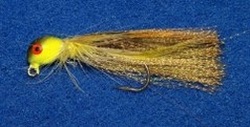
Jigs
Of all lures, I would say that jigs are the most versatile. A jig can catch about every game fish there is, and are inexpensive to boot. They have a weighted lead head and come in every size and color and can be “dressed” (think of it like a tail or skirt) in feathers, hair, a soft plastic grub, or with the bait of your choice.
Presentation
Jig fishing takes a lot of concentration, unlike spinners, all the “action” (how a lure moves in the water) comes from you. If you don’t do anything the jig just sinks. The classic way to fish a jig is to cast it out, wait until it hits the bottom (you will know it has hit bottom when your line goes slack), then retrieve it in a series of hops. You make it hop by lifting the rod tip, lowering it, and retrieving your line. Try different speeds, big lifts, little hops, twitching until you find what works. Pay attention, though. Detecting the strike is the hardest thing about jigging.
Of all lures, I would say that jigs are the most versatile. A jig can catch about every game fish there is, and are inexpensive to boot. They have a weighted lead head and come in every size and color and can be “dressed” (think of it like a tail or skirt) in feathers, hair, a soft plastic grub, or with the bait of your choice.
Presentation
Jig fishing takes a lot of concentration, unlike spinners, all the “action” (how a lure moves in the water) comes from you. If you don’t do anything the jig just sinks. The classic way to fish a jig is to cast it out, wait until it hits the bottom (you will know it has hit bottom when your line goes slack), then retrieve it in a series of hops. You make it hop by lifting the rod tip, lowering it, and retrieving your line. Try different speeds, big lifts, little hops, twitching until you find what works. Pay attention, though. Detecting the strike is the hardest thing about jigging.
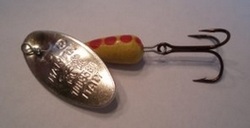
Spinners
Spinners are a great beginner lure because they are so easy to use. They are essentially a metal shaft with spinning blade. The hook can be bare or dressed. Dragging a spinner through water causes the blade to spin. The spinning motion of the blade creates sound and vibration that can be picked up by fish through their lateral line (you’ll learn more about this in the fish section.) This makes spinners an excellent choice for stained or murky water.
Presentation
Simple as can be. Cast and retrieve, that’s it. As long as the blade is spinning, its working. You can try speeding up or slowing down your retrieve for variety.
Spinners are a great beginner lure because they are so easy to use. They are essentially a metal shaft with spinning blade. The hook can be bare or dressed. Dragging a spinner through water causes the blade to spin. The spinning motion of the blade creates sound and vibration that can be picked up by fish through their lateral line (you’ll learn more about this in the fish section.) This makes spinners an excellent choice for stained or murky water.
Presentation
Simple as can be. Cast and retrieve, that’s it. As long as the blade is spinning, its working. You can try speeding up or slowing down your retrieve for variety.
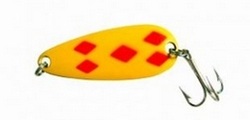
Spoons
Spoons are curved metal lures. The first spoons were just that, spoons with the handle broken off. Today, spoons can be had (like all other lures) in any color and size. There is a spoon for every fishing situation. The shape of this lure gives it its distinctive action. Spoons move through water with a side-to-side wobble that simulates an injured baitfish, and game fish just love injured baitfish.
Presentation
Some spoons are made to be cast, others to be trolled, and some even to be jigged. As a beginner you will most likely be using the most common type; the casting spoon. Casting spoons are easy to use. Like spinners, just cast and retrieve. You can vary your speed as long as it’s wobbling. If the spoon begins to spin, slow down your retrieve. Add a split ring to the eye of the lure for better action.
Spoons are curved metal lures. The first spoons were just that, spoons with the handle broken off. Today, spoons can be had (like all other lures) in any color and size. There is a spoon for every fishing situation. The shape of this lure gives it its distinctive action. Spoons move through water with a side-to-side wobble that simulates an injured baitfish, and game fish just love injured baitfish.
Presentation
Some spoons are made to be cast, others to be trolled, and some even to be jigged. As a beginner you will most likely be using the most common type; the casting spoon. Casting spoons are easy to use. Like spinners, just cast and retrieve. You can vary your speed as long as it’s wobbling. If the spoon begins to spin, slow down your retrieve. Add a split ring to the eye of the lure for better action.
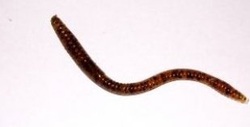
Soft Plastic Baits
Soft plastic baits encompass a variety of different lures, mostly used for bass fishing. The classic soft plastic bait is the worm. These type of baits are created by pouring liquid plastic into a mould and adding dyes, metallic flakes, or even scent. They can resemble the natural forage of fish, like worms, crawfish, lizards or frogs, but some plastic baits don’t resemble anything you might find in or out of the water; these are referred to as creature baits or “critters.” The soft plastic bodies of these lures, encourage fish to hold on to them a little longer before they spit them out, giving the angler a better chance to set the hook.
Presentation
Presentation for soft plastic baits depends on the type of bait. For the classic worm, the most popular technique is the Texas Rig. To rig your worm this way, you use a bullet weight (read the section on sinkers in theterminal tackle post if you don’t know what a bullet weight is). Thread the bullet weight on the the line above your hook, and then insert the hook through the top of the worm’s head, then bury the barb into the body of the worm to make it “weedless” (meaning it will not get hung up on underwater foliage.) Now cast it into a likely fish holding area and let it fall to the bottom. Twitch your rod tip a few times. If you still don’t have a bite, hop it back to you in short twitchy hops.
Soft plastic baits encompass a variety of different lures, mostly used for bass fishing. The classic soft plastic bait is the worm. These type of baits are created by pouring liquid plastic into a mould and adding dyes, metallic flakes, or even scent. They can resemble the natural forage of fish, like worms, crawfish, lizards or frogs, but some plastic baits don’t resemble anything you might find in or out of the water; these are referred to as creature baits or “critters.” The soft plastic bodies of these lures, encourage fish to hold on to them a little longer before they spit them out, giving the angler a better chance to set the hook.
Presentation
Presentation for soft plastic baits depends on the type of bait. For the classic worm, the most popular technique is the Texas Rig. To rig your worm this way, you use a bullet weight (read the section on sinkers in theterminal tackle post if you don’t know what a bullet weight is). Thread the bullet weight on the the line above your hook, and then insert the hook through the top of the worm’s head, then bury the barb into the body of the worm to make it “weedless” (meaning it will not get hung up on underwater foliage.) Now cast it into a likely fish holding area and let it fall to the bottom. Twitch your rod tip a few times. If you still don’t have a bite, hop it back to you in short twitchy hops.
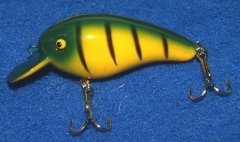
Plugs
Plugs are constructed from hollow plastic or wood to resemble baitfish, frogs or other prey. They usually sport two or three treble hooks. These hard bodied lures can be fished at almost any depth, as some are made to float or dive or both. Depending on the design, a plug will wobble, rattle or gurgle. They come in all sizes, and most of them have some sort of plastic lip that allows them to dive when you pull them through the water. Different kind of plugs include: crankbaits, jerkbaits, surface plugs, floating/diving plugs, and poppers,
Presentation
One of the most effective (and one of the first plugs you should add to your tackle box) is the long, narrow minnow imitation in three to four inch length, the original is made by Rapala. It floats when its not moving and dives shallowly when it’s retrieved. Add a split ring to the eye if it doesn’t have one. Cast it out and wait until the rings on the surface of the water dissipate, then retrieve it slowly or fast, stopping suddenly and maybe throwing in an occasional twitch.
Plugs are constructed from hollow plastic or wood to resemble baitfish, frogs or other prey. They usually sport two or three treble hooks. These hard bodied lures can be fished at almost any depth, as some are made to float or dive or both. Depending on the design, a plug will wobble, rattle or gurgle. They come in all sizes, and most of them have some sort of plastic lip that allows them to dive when you pull them through the water. Different kind of plugs include: crankbaits, jerkbaits, surface plugs, floating/diving plugs, and poppers,
Presentation
One of the most effective (and one of the first plugs you should add to your tackle box) is the long, narrow minnow imitation in three to four inch length, the original is made by Rapala. It floats when its not moving and dives shallowly when it’s retrieved. Add a split ring to the eye if it doesn’t have one. Cast it out and wait until the rings on the surface of the water dissipate, then retrieve it slowly or fast, stopping suddenly and maybe throwing in an occasional twitch.
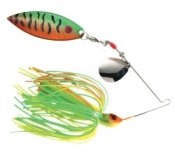
Spinnerbaits/Buzzbaits
Spinnerbaits and buzzbaits are awkward looking looking lures, consisting of a safety-pin like wire attached to a lead head body. The body usually is dressed with a rubber skirt and the arm with one or two metallic blades like those seen on spinners.
Presentation
The most common way to fish a spinnerbait is what is called “Chuck-N-Wind,” simply cast it out and retrieve it at a moderate speed, keeping the lure at a depth between the surface and five feet. It is a popular technique because it is effective.
Spinnerbaits and buzzbaits are awkward looking looking lures, consisting of a safety-pin like wire attached to a lead head body. The body usually is dressed with a rubber skirt and the arm with one or two metallic blades like those seen on spinners.
Presentation
The most common way to fish a spinnerbait is what is called “Chuck-N-Wind,” simply cast it out and retrieve it at a moderate speed, keeping the lure at a depth between the surface and five feet. It is a popular technique because it is effective.
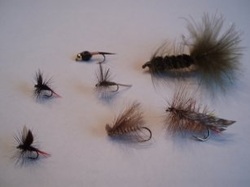
Flies
Flies are traditionally used with fly fishing equipment, but with the addition of a clear bubble float, spinning gear will cast flies too. Flies are very light lures that imitate insects in various stages of their life cycle, or other natural prey such as baitfish, leeches, hoppers or even mice and frogs. They are usually constructed of fur and and feathers, though some patterns make use of new materials like foam and rubber.
Presentation
Dry flies are intended to float on the surface of the water, to this end they are dressed with some kind of floatant to aid in their buoyancy. Wet flies, like nymphs and streamers are designed to be fished below the surface of the water. Fly fishing is a difficult but rewarding area of the fishing universe.
Now that you know the basic lures and how they are used, you should have an easier time starting your own collection. Buy only a few at a time, and take the time to learn to fish them. If you know anyone that fishes the same water you do, ask them what kind of lures they like to use and what they recommend.
Flies are traditionally used with fly fishing equipment, but with the addition of a clear bubble float, spinning gear will cast flies too. Flies are very light lures that imitate insects in various stages of their life cycle, or other natural prey such as baitfish, leeches, hoppers or even mice and frogs. They are usually constructed of fur and and feathers, though some patterns make use of new materials like foam and rubber.
Presentation
Dry flies are intended to float on the surface of the water, to this end they are dressed with some kind of floatant to aid in their buoyancy. Wet flies, like nymphs and streamers are designed to be fished below the surface of the water. Fly fishing is a difficult but rewarding area of the fishing universe.
Now that you know the basic lures and how they are used, you should have an easier time starting your own collection. Buy only a few at a time, and take the time to learn to fish them. If you know anyone that fishes the same water you do, ask them what kind of lures they like to use and what they recommend.


 RSS Feed
RSS Feed
